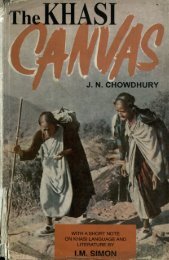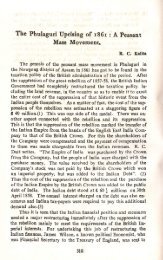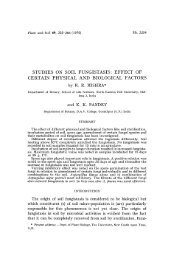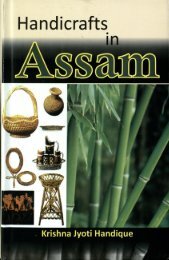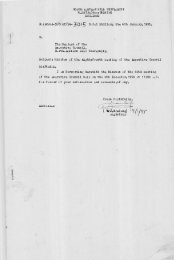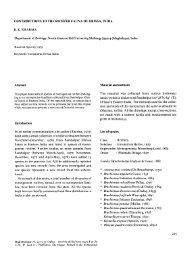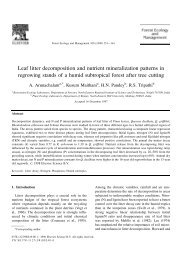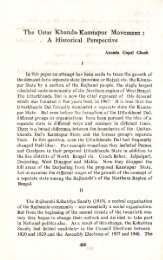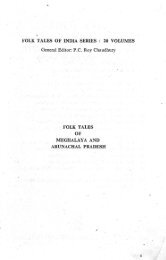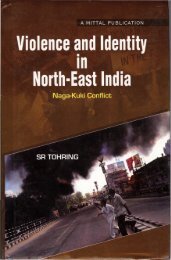Ethics and Envirnmnt.pdf - DSpace@NEHU - North-Eastern Hill ...
Ethics and Envirnmnt.pdf - DSpace@NEHU - North-Eastern Hill ...
Ethics and Envirnmnt.pdf - DSpace@NEHU - North-Eastern Hill ...
You also want an ePaper? Increase the reach of your titles
YUMPU automatically turns print PDFs into web optimized ePapers that Google loves.
t tlt/C8 dnd eflV/rOflfHent<br />
THEORY AND THE ADI AND KHASI PRACTICE<br />
179.1095416<br />
MlR<br />
003378<br />
ICSSR
ETHICS<br />
AND<br />
RONMENT<br />
he Adi <strong>and</strong> Khasi practice)<br />
SUJATAMIRI<br />
SPECTRUM PUBLICATIONS<br />
GUWAHATI: DELHI
Ill" 11111111111111<br />
003378<br />
SPECTRUM PUBLICATIONS<br />
• Panbazar Main Road;<br />
Post Box No. 45, GUWAHATI-781 001<br />
• 298-B Tagore Park Extn.,<br />
Model Town-l, DELHI-ll 0009<br />
Tel. (011)724-1674 email: spectrumjsid.eth.<br />
I •..<br />
First Published 2001<br />
© Author<br />
All rights reserved. No part of this publication may be<br />
reproduced or translated, in any form or by any means, without<br />
written permission except for brief passages for critical reviews.<br />
Please address all enquries to the publishers.<br />
ISBN 81-87502-35-5<br />
Sole Distributors:<br />
United Publishers<br />
• Panbazar, Main Road, GUWAHATI-781 001<br />
Tel.(0361 )517059 email: unipub@gwl.dot.net.in<br />
• L G-6 Akarshan Bhavan<br />
23 Ansari Road, NEW DELHI-l 10 002<br />
Tel. (011)324-1471<br />
Published by<br />
Krishan Kumar on behalf of Spectrum Publications <strong>and</strong><br />
printed in India at D.K. Fine Art Press, Delhi-l 10 052
CONTENTS<br />
1. Preface VI<br />
2. Introduction VU<br />
:}.Illustrations<br />
Xlll<br />
4. Chapter I :<br />
The Modern Divide 1<br />
5. Chapter 11:<br />
Nature - A Thing of Beauty 11<br />
6. Chapter III :<br />
Back to <strong>Ethics</strong> 27<br />
'1. Chapter IV :<br />
The Tribesman as the Interlocutor 54<br />
8..Appendix 93
PREFACE<br />
In the normal scheme of ethical evaluation, nature does not<br />
come into the picture at all, <strong>and</strong> if it does, it does only in its capacity<br />
to be instrumental in preserving <strong>and</strong> furthering the cause of man as a<br />
creature of value. Nature, in other words, is seen as having no intrinsic<br />
value of its own. Its value, when it is there, is only instrumental <strong>and</strong>,<br />
therefore, contingent.<br />
Philosophy, or ethics, or aesthetics as conventionally construed<br />
in the west cannot adequately deal with the environmental crisis.<br />
Rather all these are part of the crisis itself, <strong>and</strong> therefore, cannot be<br />
used as a way of dealing with them. Hence in my work I have explored<br />
a variety of pre-rnodern ways, namely theAdi <strong>and</strong> the Khasi (of <strong>North</strong><br />
East India), of looking at nature in which it may be possible to find a<br />
place for a central evaluative concern for nature <strong>and</strong> environment. I<br />
would have liked to have been able to do a much more detailed work<br />
on the living thought <strong>and</strong> practices of the tribes of <strong>North</strong>- East India.<br />
But as the secondary material is both scanty, terribly territorystereotyped,<br />
this would have involved my travelling extensively in<br />
the area to talk to the people, partake of their life <strong>and</strong> learn.<br />
Unfortunately, for a variety of reasons, this could not be arranged.<br />
Perhaps this will be my next project.<br />
This work has been completed with the assistance of the Indian<br />
Council of Philosophical Research who very generously awarded me<br />
a fellowship for a project on '<strong>Ethics</strong> <strong>and</strong> Environment'. To the Indian<br />
Institute of Advanced Study in Shimla I owe special thanks for offering<br />
me affiliation <strong>and</strong> study <strong>and</strong> library facilities.<br />
Above all I am most grateful to Mr. L.K. Das for his help in<br />
preparing the manuscript.<br />
Sujata Miri
INTRODUCTION<br />
My main concern in this work has been to try <strong>and</strong> answer the<br />
question, "How is environmental ethics possible?" The original<br />
intention ~ if that is the right word - was to write an essay<br />
recognizably within the domain of a conventional philosophical work<br />
complete with analysis, argumentation <strong>and</strong> conclusions. But what I<br />
have actually produced is nothing of the kind. While my basic concern<br />
does remain philosophical, the work is not a sustained analytic<br />
argument or series of arguments for a particular thesis; nor does it<br />
consist in the detailed working out of a position from a critique of a<br />
variety of philosophical theses <strong>and</strong> arguments. Analysis,<br />
argumentation <strong>and</strong> critical evaluation of philosophical positions are<br />
certainly there; but they serve a secondary rather than a primary<br />
purpose. My jusitification for this is that so-called "rigorous"<br />
philosophising is frequently a trap which shuts out all true illumination<br />
<strong>and</strong> creates only an illusion of light. What I have done here is to put<br />
together a series of thoughts related to each other in many different<br />
ways - but all of them woven around the theme of the possibility of a<br />
genuinely evaluative concern for nature.<br />
Part I of the work deals with what I call the modern divide:<br />
this is the divide between mind <strong>and</strong> matter, man <strong>and</strong> nature, fact <strong>and</strong><br />
value, science <strong>and</strong> faith <strong>and</strong> so on. Of course, there are intimations of<br />
such a divide in pre-modern times as well; but in modernity this<br />
divide takes on a character of ultimacy which affects all our ways of<br />
organizing our experiences of ourselves <strong>and</strong> of the world <strong>and</strong> of<br />
underst<strong>and</strong>ing our predicament. Given this divide, ethics or morals<br />
can only be understood as belonging firmly to the domain of man.<br />
<strong>Ethics</strong> regulates man's relationship with others of his own species.<br />
This must be so - so it would appear - irrespective of whether one<br />
believes that the nature of ethical obligation is grounded in our<br />
subjectivity, or that it is grounded in the objectivity of values or in<br />
our rational nature or what have you. If morals have thus only to do<br />
with my relationship with other human beings, what kind of evaluative
V1ll<br />
<strong>Ethics</strong> <strong>and</strong> Environment<br />
concern could, then, there be for nature or for the non-human world<br />
within the modern divide? Well, utilitarianism or consequetialism in<br />
respect of the non-human world, is a natural response : we must<br />
respect or value nature because that is the only way to ensure our<br />
own well-being <strong>and</strong> survival. And, this response is available to people<br />
irrespective of whether they are subjectivists in their ethics, or<br />
objectivists, or deontologists or virtue-ethicist or feminists. The<br />
difficulty with this approach - as with modernity as such - is, of<br />
course, that it is too human-centred for it to be able to give an adequate<br />
meaning to the concept of respect as applied to non-humans. It can<br />
be argued - I think with justification, that utilitarian or<br />
consequentialist "respect" cannot really count as respect. Respect is,<br />
after all, a kind of knowledge - knowledge that the object of respect<br />
is valuable independently of its use for the respecter.<br />
Another response might be that of the aesthetician of nature.<br />
This is largely my concern in Part 11of the work. Nature can be the<br />
object of aesthetic experience of more or less intense kinds; <strong>and</strong> any<br />
object of aesthetic experience must have qualities which are valuable<br />
- which constitute its beauty. But the aesthetic response is just as<br />
difficult to articulate within the modern divide as the utilitarian<br />
response. It may turn out to be just as equally man-centred - as, for<br />
instance in Kant - as the utilitarian response. Or, it may collapse into<br />
a self-cloying romanticism of an abstract kind. In any case, this<br />
response will have to come to terms with such assumptions of modem<br />
aesthetics as that there is a categorial difference between the artifactual<br />
<strong>and</strong> the natural - whether organic or inorganic - that art has to do with<br />
human creativity <strong>and</strong>, therefore, with the artifactual.<br />
The response of the ecologist, (which is my concern in Part<br />
III) the deep ecologist <strong>and</strong> the ecofeminist is bold <strong>and</strong> desperate. It is<br />
bold because it dares to take on the great hegemonic authority of the<br />
modern divide; <strong>and</strong> it is desperate because it appears to itself as<br />
entangled in a fight to the finish - a fight in which it is, in every way,<br />
an unequal combatant. Frequently, this leads to a flight - <strong>and</strong> the<br />
flight is into the domain of post-modernism. But post-modernity is
INTRODUCTION<br />
IX<br />
only a development out of modernity - <strong>and</strong> the modern divide is just<br />
as much a creed of post-modernity as it is of modernity. Postmodernity<br />
merely questions the autonomy of the idea of objectivity<br />
- "objectivity" for it, is a creature of subjectivity or relativity -<br />
paradoxical as it may sound; but man <strong>and</strong> nature remain as distant in<br />
post-modernity as in modernity. *<br />
In Part IV of the work, I turn away, therefore, from the entire<br />
western debate' <strong>and</strong> see, if there is a way out in non-western, premodern<br />
thought <strong>and</strong> practice. I offer here thoughts on tribal worldviews.<br />
The important thing to realise about tribal thought is that it is<br />
seamless - free from divides of the kind that modem thought is<br />
driven by. Man, animal, nature, the earth, the sun <strong>and</strong> the moon belong<br />
to a continuum <strong>and</strong> form a natural - if cosmic - moral community<br />
which they must all sustain. Moral obligation springs neither from<br />
subjective compulsions, nor from the autonomy of the rational will;<br />
nor from utility to man's life <strong>and</strong> his well-being; nor indeed from any<br />
deontological status of the moral rights. It springs rather from the<br />
sacredness of the entire natural order. Man, animal, trees, mountains,<br />
forests, rivers are equal members of a community with inalienable -<br />
because sacred - obligations, duties, to one another. Here responsibility<br />
is not a function narrowly of human freedom. It is something that<br />
emanates from the order of nature itself. Any violation of the order<br />
whether by humans or non-humans is a failure of responsibility, <strong>and</strong><br />
receives punishment in one way or another. Tribal thought is strictly<br />
non-hierarchical. No species exists for the sake of another - rather<br />
all exist for the sake of all- for the sake of the entire community of<br />
species which is sacredly grounded. No member of this community<br />
has a place lower in moral status <strong>and</strong> responsibility than another -<br />
rather the place of each confers a responsibility <strong>and</strong> status to it<br />
uniquely its own. Humans - because of their egoism <strong>and</strong> vanity - are<br />
ever inclined to violate the natural moral order. This is why moral<br />
education is crucial for humans - <strong>and</strong> tradition is the great educator.<br />
Tradition does it - not through abstract, analytic, ratiocinative<br />
argumentation - because such procedure cannot possibly take account<br />
of the great delicacy <strong>and</strong> complexity of relationships between different
x<br />
<strong>Ethics</strong> <strong>and</strong> Environment<br />
members of the cosmic moral community. Tradition does it through<br />
poems <strong>and</strong> songs <strong>and</strong> stories - sung <strong>and</strong> told in appropriate contexts<br />
<strong>and</strong> appropriate times <strong>and</strong> by the appropriate people.<br />
All this, of course, is anathema to the modern mind, because<br />
modernity, for it, consists precisely in the "liberation" of the modern<br />
mind from "traps" such as the tribal way of thought <strong>and</strong> life represents .<br />
. ThIS "liberation" consists in the affirmation of the uruquensess of<br />
human freedom <strong>and</strong> of the superiority <strong>and</strong> autonomy of human<br />
rationality. Unfortunately, however, this idea of human freedom might<br />
well be entirely illusory <strong>and</strong> human rationality might well prove to<br />
be a conglomerate of self-enclosed systems which have little or<br />
nothing to do with the idea of truth as an independent entity. The<br />
natural consequence of such developments is complete<br />
"materialization" of man, on the one h<strong>and</strong>, <strong>and</strong> an all pervasive<br />
relativism, on the other - relativism between different systems of<br />
thought <strong>and</strong> knowledge, between different cultures <strong>and</strong> moralities.<br />
In such an eventuality moral obligation, as an over-riding principle<br />
of action will have no meaning; <strong>and</strong> respect for nature may merely<br />
be just a culture-specific eccentricity. Tnbal thought <strong>and</strong> practice are<br />
founded on the sacred grounding of all creatures - human <strong>and</strong> nonhuman;<br />
<strong>and</strong>, while all tribal thought <strong>and</strong> practice is localized - bound<br />
to the l<strong>and</strong>, as it were - the basis of this localised efflorescence is<br />
what might be called a mundane - entirely non-esoteric spirituality<br />
which IS common to all tribal cultures, it IS, therefore, to the great<br />
advantage of tribal thought, that it is not beset by problems of<br />
relativity. To modernity it can say with perfect legitimacy: "you have<br />
gone terribly astray; if you could only return to your roots, you would<br />
find a way to be at peace with yourself <strong>and</strong> with all around you.<br />
There will be pluralism there, but not relativism. The other, including<br />
the tribal other, is an equal member of the great "community of<br />
beings." Unfortunately, this "return" - by sheer compulsion of forces<br />
that modernity has unleashed - can only be a dream <strong>and</strong> for most of<br />
those who think they have achieved it - as e.g. in the so-called "hippy"<br />
movement - it is only, as in Freudian psychology, a "dream"<br />
achievement - not a real one.
INTRODUCTION<br />
XI<br />
One possibility I have not considered in the main body of the<br />
work is a reconci liation - from the modern divide, that is - that can be<br />
sought inreligion.v- Some religions have, of course, played the role<br />
of modernity's partner - partner in the great drama of our times to the<br />
extent that they see things the way that modernity dictates.But there<br />
may still be others which may provide the basis for a non-devisive<br />
vision. I am tempted to suggest that there are also religions where<br />
the tribal vision of the sacredly grounded comrnumty ofbeingsrnight<br />
still be alive. On may think here of some str<strong>and</strong>s of Hindusim, of<br />
Jainism <strong>and</strong> certainly much of Buddhism. Take the no-self doctrine<br />
of Buddhism. [This might have correspondences with the all-self<br />
doctrine of advaita, but that is another story.] This may be treated as<br />
a mere dogma of Buddhism - whose truth isfixed, as it were, by fiat.<br />
But the no-self view - which has resounding echoes in Wittgenstein -<br />
can quite conceivably translate into practice; <strong>and</strong>, thus translated,<br />
can strike at the very heart of the modern divide between the<br />
self <strong>and</strong> the other <strong>and</strong> be the beginning of a moral transformation<br />
where ezolessness <strong>and</strong> compassion for all beings are the true springs<br />
ot all action. Such a transformation may, of course, also be coincident<br />
with a spiritual experience of "nothingness" or of the world as a<br />
"limited whole" (Wittgenstein) or to a blazing vision such as the<br />
following:<br />
"Far away in the heavenly abode of the great God Indra, there<br />
is a wonderfui net which has been hung oysorne cunning artificer in<br />
such a manner that it stretches out infinitely in all directions. In<br />
accordance with the extravagant taste of deities the artificer has hung<br />
a single glittering jewel in each "eye" of the net, <strong>and</strong> since the net is<br />
infinite in dimension, the jewels are infinite in number. There hung<br />
the jewels, glittering like stars of the first magnitude, a wonderful<br />
sight to behold. If we now arbitrarily select one of these jewels for<br />
inspection <strong>and</strong> look closely at it, we will discover that in its surface<br />
there are reflected all the other jewels in the net, infinite in number.<br />
Not only that, but each of the jewels retlected in this one jewel is also<br />
reflecting all the other jewels, so that there is an infinite reflecting<br />
process occurnng.
XII<br />
<strong>Ethics</strong> <strong>and</strong> Environment<br />
This powerful image is, among other things, a symbol of the<br />
cosmos in which there is an infinitely repeated interrelationship<br />
among the members of the cosmos - a more than adequate basis for a<br />
serious ethics of environment.<br />
* Masters of post-modernity such as Foucault, Derrida, Boudrillard can all be<br />
understood to have argued from a position like this.<br />
** This is explored fairly extensively in my already published works on tribal<br />
religions.
1. Man made himself centre of the universe.<br />
2. Man, self-satisfied sits on the ruins of nature
(J)<br />
(J)<br />
ID<br />
-0<br />
-0<br />
g,<br />
I<br />
C<br />
:::J<br />
C/)<br />
-0<br />
C<br />
CO<br />
€<br />
CO<br />
ID~ID<br />
...c:<br />
(5<br />
~<br />
(J)<br />
c<br />
2 co<br />
~ ...c:<br />
-C IDEo,<br />
o<br />
ID<br />
><br />
ID<br />
o
4. The original glory of the Sun <strong>and</strong> the Moon, the sacred<br />
rivers, sacred forests, <strong>and</strong> above all, love threatened ....<br />
5. Mother-earth the most revered deity.
6. The womb of Pedong Nane.
<strong>Ethics</strong> <strong>and</strong> Environment<br />
takes a critical look at the growing<br />
literature on the possibility of. a<br />
moral discourse of which the<br />
human reality is not the exclusive<br />
domain. The "modem" man's<br />
ethical concern with the<br />
environment in its diverse form<br />
remains, according to the author,<br />
inadequate because of its inability<br />
to transcend some of the<br />
conventionally rigid boundaries of<br />
"rational" argumentation. By<br />
contrast she argues that the nonanthropocentric<br />
concern <strong>and</strong> modes<br />
of articulation of tribal cultures<br />
provide a much sounder basis for<br />
an environmental mortality.<br />
The book will be useful<br />
both to students at various<br />
undergraduate <strong>and</strong> post-graduate<br />
levels as well as to researchers.<br />
The front cover depicts in the top<br />
panel The Sky God <strong>and</strong> his wife-<br />
Lightning <strong>and</strong> the bottom panel<br />
shows The circles of creation. All<br />
illustrations are by the author.<br />
ISBN 81-87502-35-5<br />
Sujata Miri is a Professor of Philosophy<br />
in <strong>North</strong>-<strong>Eastern</strong> <strong>Hill</strong> University,<br />
Shillong. At present she is also the Head<br />
of its Department of Philosophy. She has<br />
done extensive research into the<br />
philosophies of tribal peoples- particularly<br />
of the <strong>North</strong>-east. During her long career<br />
as a teacher <strong>and</strong> supervisor of research she<br />
has inspired generations of students to<br />
take deep philosophical interest in their<br />
own cultures. Her published works in<br />
book form include: Suffering, Religion<br />
<strong>and</strong> Society: <strong>North</strong>-East India (Ed), The<br />
Khasi World View: A Conceptual<br />
Exploration, Liangmai Nagas: Legends<br />
<strong>and</strong> Stories, Communalism in Assam: A<br />
Civilizational Approach.<br />
Sujata Miri has also published a<br />
novel entitled, Days <strong>and</strong> Nights, which<br />
has received wide acclaim. Another novel<br />
is complete <strong>and</strong> will be published in the<br />
near future. Another interesting<br />
accomplishment is in the area of painting.<br />
Her paintings- most of them thematically<br />
unusual <strong>and</strong> surprising- have been<br />
exhibited in some of the larger cities <strong>and</strong><br />
have earned much praise from critics.<br />
Cover Design: Spectrum Studio<br />
Rs 240
•.-j.<br />
I" "<br />
Books on India's <strong>North</strong>-East from SPECTRUM PUBLICATIONS<br />
Author Title ISBN Price Rs<br />
W.W. Hunter :A StatisticalAccount of Assam (2 voVl998Rep) 81-85319-91-X 680<br />
Major Playfair :The Garos(1998 Reprint) 81-85319-78-2 290<br />
Verrier Elwin: Nagal<strong>and</strong> (1997 Reprint) .81-85319-77-4 425<br />
Sir Charles Lyall : The Karbis (Revised edn) ...~" 81-85319-76-6 290<br />
Mrs P.H.Moore : Stray Leaves from Assam 81-85319-75-8 195<br />
Mrs P.H.Moore : Autumn Leaves from Assam 81-85319-74-X 165<br />
O:L.Swanson: In Villages<strong>and</strong> Tea Gardens 81-85319-73-1 195<br />
C:Lalkima : SocialWelfareAdministrationin a Tribal State - 81-85319-72-3 320<br />
A.Grignard :Hahn's Oraon Folklorein the original 81-85319-71-5 220<br />
Robert Reid:History of frontier areas borderingon Assam(1883-1945) 81-85319-70-7 295<br />
William Shaw :Notes on the ThadouKukis 81-85319-69-3 240<br />
Hamlet Bareh Ngap Kynta:History&Culture of the Khasi People(3/ed)81-85319-68-5 395<br />
Pulloppillil & Aluckal :TheBodos - Childrenof Bhullumbutter 81-85319-65-0 220<br />
Girin Phukon :Politicsof Regionalismin <strong>North</strong>east India<br />
81-85319-62-6 hb240<br />
Yasrnin Saikia : In the Meadows of Gold 81-85319-61-8 395<br />
Jnanan<strong>and</strong>a Sanna PathakAssam: Her Men of Letters VolI 81-85319-60-X 395<br />
H.KBarpujari: Francis Jenkins Report on the NE Frontier 81-85319-59-6 340<br />
AjayRoy:TheBoroImbroglio, 81-85319-58-S 195<br />
Lalrimawia :MizoramHistory& Cultural.Identity, 81-85319-57-X 340<br />
Janapathy : IsolatedL<strong>and</strong>s & their Gentle Women 81-853,1~-56-1 hb260<br />
Bradley-Birt : Dacca - The Romance Of an <strong>Eastern</strong> Capital 81-853i9-50-2 240<br />
Kamaluddin Ahmed:Art & Architecture of Assam 81-85319-45-6 395<br />
Santo Barman :ZamindariSysteminAssam during BritishRule 81-85319'-52-9 295<br />
Lianzela :Economic DevelopmentofMizoram' 81-85319-53-7 270<br />
Geoffrey Tyson : Forgotten Frontier 81-85319-46-4 220<br />
A.K Yogi :Developmentof the <strong>North</strong> East Region - 81-85319-42.1 320<br />
M.Narrimatam: The Valleyin Blossom ' 81-85319-36-7 hb175<br />
P.C.Choudhury :AssamBengal relations-fromearliesttimes to 12th cen81-85319-40-5 220<br />
P.C.Barua: The Saga of Assam Oil 81-85319-87-1 440<br />
U.N.Gohain : Assam under the Ahoms 81-85319-9~-7 195<br />
Lt.Col Alban Wilson : Sport <strong>and</strong> service in Assam & Elsewhere 81-85319-11-1 240<br />
Tr. & Ed by: Golap Ch. Barua :AhomBuranji 81-85319-25-1 270<br />
L.Atola Changkiri: The AngamiNagas <strong>and</strong> the British (1832-1947) 81-85319-89-8 340<br />
Sudhindra Nath Bhattacharyya:History of MughaIN E FrontierPolicy81-85319-95-2 395<br />
Priyam Goswami: Assam in the Nineteeenth Century 81-85319-94-4 325<br />
Lalit Kumar Barua: Oral tradition<strong>and</strong> Folk heritageof NE India 81-87502-02-9 280<br />
Edward A. Gait:Report on the progressof historicalresearch in Assam 81-87502-06-1 395<br />
Indrani Dutta : Japanese invasion ofIndia (1944) Myth or reality? 81-87502-05-3 220<br />
Hamlet Bareh Ngap Kynta:The Economyof Meghalaya(200III st Edn)81-87502-11-8 440<br />
KLPradhan: Brian Hodgson atthe Kathm<strong>and</strong>u Residency(1825·1843) 81-87502-15'{) 395<br />
K.K.Muktan: The Legendary Gurkhas 81-87502-36-3 FIC<br />
Malsawma: Sociology of the Mizos 81-87502-37-1 FIC<br />
Distributors: united<br />
publishers<br />
• Panbazar Main Road, Post Box No 82, GUWAHATI-781001,Assam<br />
Tel. 517059,Fax. (0361)544791.Cables :unipub,emai1:unipub@gw1.dotnet.in<br />
·LG-6 AkarshanBuilding, 23 Ansari Road, NEW DELHI -110002. Tel. 324-1471



